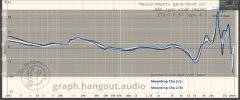Considering the uncertainty/error of any HP/IEM measurements, the fact that a target is just that—a target—but it’s not the exact (unknow) “target” for any individual, why are you trying to match exactly HK IE 2019 v.2?
I would argue that 5x DSP filters is “good enough” to get close to ‘a’ target and explore around… And if it’s not good enough, then Chu-II is certainly not the right IEM for the desired outcome.
Among the Audio Science Review tests I found only 3 transducers from electrical signal to acoustic pressure that have the following characteristics:
- THD always less than 1% at any audible frequency at any sound pressure up to the maximum bearable for the human ear.
- Possibility of equalization by very high approximation of the Harman Kardon IE 2019 v.2 curve (I believe the latest available with a certain reliability) with a parametric equalizer equipped with a number of filters that does not exceed 10/15 filters.
These devices are (if I'm not wrong) the following:
- Truthear x Crinacle Zero: RED
- 7Hz Sealnotes x Crinacle Zero:2
- Moondrop Chu II
Of these, the Zero:RED are the least comfortable in terms of size/encumbrance and weight. They are also two-way IEMs, so with all the problems associated with passive crossover filters (phase shifts in the crossover area, etc.) and they are reactive loads very far from an ideal purely resistive load that greatly helps the stability of the entire reproduction system. They also have a very low impedance that can overload the headphone power output stage. Finally, they are the most expensive of the three models listed.
The 7Hz Selanotes x Crinacle Zero: 2 seem to be the best (lowest THD overall, highest impedance than the others, practically resistive load), but they cost about double the Moondrop Chu II, are bulkier, heavier and their pads are less comfortable (at least in my opinion).
The Moondrop Chu II distort a little more than the 7Hz, but they are smaller, weigh less and (again in my opinion) are more comfortable. They have a constant impedance, so they are practically resistive loads. Their sensitivity is not too high to make the noise floor of the headphone amplifier's output stage audible, and it is not too low to make them unusable in portable applications. They are also the ones that cost the least.
I don't understand why they shouldn't be suitable to approximate the HK IE 2019 v.2 curve. Any other suggestions?
Crinacle measurements are often performed on multiple samples of the same IEMs model. They are performed with B&K 5128/4620 instruments which at the moment seem to be the closest to the (average) human ear available.
If we want to question the H&K curve, we can do so, but what objective reference do we then consider to establish the quality of an earphone? Personal taste? So do we indulge in total subjectivism? Maybe we go back to the loudness control of the 70s?

